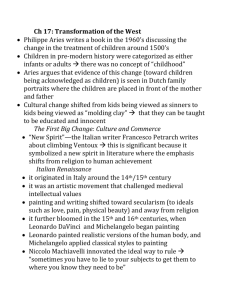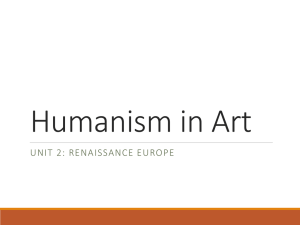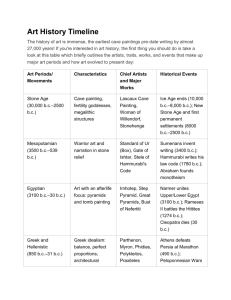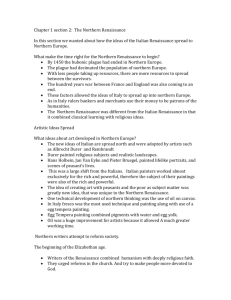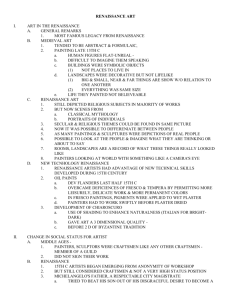Reading Questions
advertisement
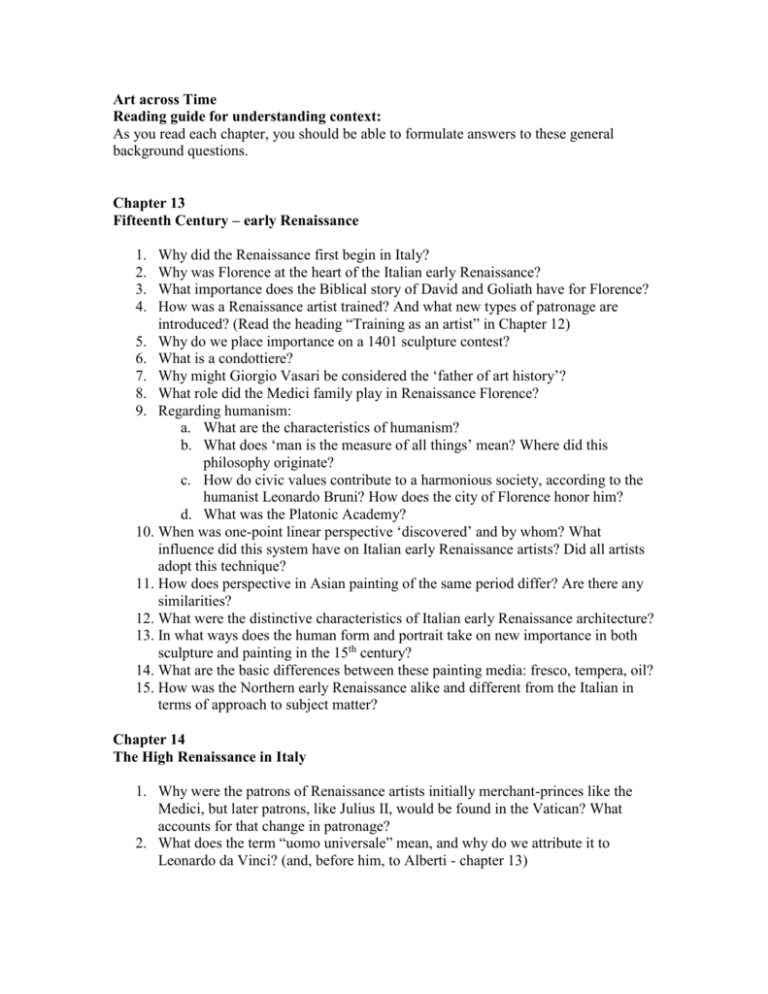
Art across Time Reading guide for understanding context: As you read each chapter, you should be able to formulate answers to these general background questions. Chapter 13 Fifteenth Century – early Renaissance 1. 2. 3. 4. Why did the Renaissance first begin in Italy? Why was Florence at the heart of the Italian early Renaissance? What importance does the Biblical story of David and Goliath have for Florence? How was a Renaissance artist trained? And what new types of patronage are introduced? (Read the heading “Training as an artist” in Chapter 12) 5. Why do we place importance on a 1401 sculpture contest? 6. What is a condottiere? 7. Why might Giorgio Vasari be considered the ‘father of art history’? 8. What role did the Medici family play in Renaissance Florence? 9. Regarding humanism: a. What are the characteristics of humanism? b. What does ‘man is the measure of all things’ mean? Where did this philosophy originate? c. How do civic values contribute to a harmonious society, according to the humanist Leonardo Bruni? How does the city of Florence honor him? d. What was the Platonic Academy? 10. When was one-point linear perspective ‘discovered’ and by whom? What influence did this system have on Italian early Renaissance artists? Did all artists adopt this technique? 11. How does perspective in Asian painting of the same period differ? Are there any similarities? 12. What were the distinctive characteristics of Italian early Renaissance architecture? 13. In what ways does the human form and portrait take on new importance in both sculpture and painting in the 15th century? 14. What are the basic differences between these painting media: fresco, tempera, oil? 15. How was the Northern early Renaissance alike and different from the Italian in terms of approach to subject matter? Chapter 14 The High Renaissance in Italy 1. Why were the patrons of Renaissance artists initially merchant-princes like the Medici, but later patrons, like Julius II, would be found in the Vatican? What accounts for that change in patronage? 2. What does the term “uomo universale” mean, and why do we attribute it to Leonardo da Vinci? (and, before him, to Alberti - chapter 13) 3. The High Renaissance is dominated by six individual artists and one Venetian family. Name them. 4. What importance does the circle have to artists and architects of this time? How is this concept manifested in the central plan of Bramante’s Tempietto and in Michelangelo’s design for St. Peter’s? 5. Why might we consider Leonardo’s Last Supper both his greatest achievement and greatest failure? 6. Quoting from the text: “The painting that epitomizes Leonardo’s synthesis of nature, architecture, human form, geometry, and character is the Mona Lisa.” What does Schneider Adams mean? 7. Which two early works in marble establish Michelangelo’s reputation as a sculptural genius? Why? 8. What is the theme of the Sistine ceiling? How does typology manifest in the work? (Check the glossary if unsure of the definition of typology.) 9. Michelangelo’s late style, as exemplified by the Last Judgment fresco, the Laurentian Library and the Rodanini Pietá, is a subject for art historical debate. Why do some scholars see it as the end of the Renaissance, and others as part of the new Mannerist style? (Look ahead to chapter 15 for Mannerist characteristics) 10. Both Raphael and Leonardo often used a triangle or pyramid shape for their compositions. Discuss that compositional device in both formal and symbolic terms. 11. What is the complex meaning of the paintings in the Stanza della Segnatura by Raphael? What are the themes of this program of frescoes? How does the School of Athens promote and emphasize the ideals of the Renaissance? 12. Compare and contrast the Disputation over the Sacrament (the Disputa) with the School of Athens. 13. What is the character of society in Venice at this time? How is it like and unlike that of Florence? 14. Which artist is credited with bringing the Renaissance style to Venice? 15. Why does oil painting become the dominant medium in Venice? 16. Discuss these four typical characteristic of Venetian painting: a. rich, sensuous color b. idealized landscape c. mythological subjects d. painting in oil on canvas 17. Why is there confusion about the some of the 1505-1510 paintings of Giorgione and Titian? 18. The similarities between Giorgione’s Sleeping Venus and Titian’s Venus of Urbino are fairly obvious; what are the significant differences? Chapter 15 Mannerism and the Later Sixteenth Century in Italy 1. What was the Reformation? (see Chapter 16 as well) 2. What was the Counter-Reformation? What institution was founded to enforce religious orthodoxy? 3. What does the term ‘Mannerism’ mean in terms of Italian art after 1520? 4. What is the main subject of Mannerism? 5. How do Mannerist artists differ from earlier Renaissance artists in their approach to painting? Address the human form, symmetrical vs. asymmetrical composition, and the use of space, color, proportion and scale. 6. Can you discuss some of those same characteristics in the sculptures of Cellini and Giambologna? 7. What breaks with Renaissance architecture are found in the Palazzo del Té? 8. Why might we say that Mannerist art celebrates ‘artificiality’? 9. Compare Mantegna’s ceiling for the Camera Picta (Chap 13), with the Sala dei Giganti ceiling by Romano in the Palazzo del Té. Similarities? Differences? 10. How did the Venetian painter Veronese respond to the judgment of the Inquisition? 11. How do the works of Tintoretto and El Greco express the aims of the CounterReformation? 12. Why does the text name Andrea Palladio as the ‘single most important architect of his generation,’ and what influential treatise did he author? Chapter 16 Sixteenth Century Painting and Printmaking in Northern Europe 1. How did the actions of Martin Luther set the Protestant Reformation into motion? 2. What are proverbs, and how are they related to humanism in Northern Europe? 3. Discuss some of the ways that Hieronymous Bosch’s Garden of Earthly Delights has been interpreted. 4. Compare the use of landscape in one painting in Chapter 16, and one painting from 16th century Italy. Be sure to consider scale, how much landscape is shown, the organization of space, observation and naturalism, the place of figures in the landscape, and light. Is landscape merely a backdrop, or does it add meaning to the painting? 5. Discuss moralizing themes in the works of Pieter Breugel the Elder. 6. Discuss Durer’s interest in line in both his paintings and prints. 7. Describe the differences between the printmaking techniques of engraving and woodcut. 8. The text discusses the origins of the ‘myth of the mad artist.’ Do you believe there is any validity to the theory? Does that image of the artist still persist today? 9. Discuss the contrasting themes found in the closed vs. the open state of Grunewald’s Isenheim Altarpiece. 10. Who was Erasmus of Rotterdam? How did his writings encourage religious reform? 11. How does Holbein the Younger use setting, pose and costume to tell very different stories in his portraits of Erasmus of Rotterdam and Henry VIII?
